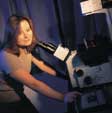 Kinetochore
junction "We want to understand how these events work," he said. "I think of them as little machines. They do work by using chemical energy to move chromosomes."l. He also wants to understand how they don't work. Healthy cells have a quality-control mechanism built into the kinetochore that ensures cells don't divide until all chromosomes are properly attached to microtubules. However, in some cancers, this checkpoint malfunctions and the cells go through division before all the chromosomes are attached to the microtubules. This cellular misstep can turn a benign tumor malignant. "You can think of these events as helping to increase the rate of selective mutation, which gives rise to cells growing faster and migrating throughout the body," Kaplan said. "These are the cellular activities that make people very sick and kill them." The formation of more than one kinetochore on a chromosome results
in "The chromosomes are just floating around the cell. They are not attached to the microtubule tracks and can't be moved equally from mother to daughter cells," Kaplan said. "So they are randomly segregated."
Home |
Table of Contents |
To our Readers |
Building on Basics UC Davis Health System | © 2000, 2001, 2002 UC Regents. All rights reserved. |
Biochemistry and molecular biology graduate student Annette Lentz is interested in understanding how normal cells prevent mistakes from occurring during chromosome segregation. |

